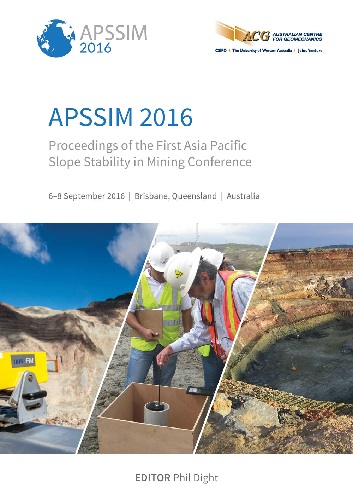Geotechnical challenges in development of El Soldado open pit

|
Authors: Bermedo, EO; Cordova, NA |
DOI https://doi.org/10.36487/ACG_rep/1604_16_Bermedo
Cite As:
Bermedo, EO & Cordova, NA 2016, 'Geotechnical challenges in development of El Soldado open pit', in PM Dight (ed.), APSSIM 2016: Proceedings of the First Asia Pacific Slope Stability in Mining Conference, Australian Centre for Geomechanics, Perth, pp. 301-312, https://doi.org/10.36487/ACG_rep/1604_16_Bermedo
Abstract:
During the development of Phase 3 of El Soldado open pit, structurally controlled instabilities at the bench level were detected. The operational strategy was to scale down the blocks in order to leave a clean wall, free of loose rocks. As background, it was known the California Fault was close to the slope (Regional Fault, subparallel to the orientation of the slope). As the development of the phase continued, there were identified unstable conditions at bench level. A detailed structural analysis of the observed condition detected an area of convergence of faults that generated an area of greater damage in the central sector of the wall of the phase, causing the continuous instabilities observed. With the updated structural information it was determined that instability belonged to a wedge that did not daylight, it was called the Central Wedge. The trace of the California Fault was re-interpreted very close to the pit wall design. Because of this, and knowing the behaviour in areas of convergence of faults, it was decided to modify the pit design to ensure that the wall (or slope) was behind the plane of the California Fault. The decision was to increase the inter ramp angle from 55 to 65° at a height of 105 m and a length of 400 m. To successfully develop a stack of benches with inter ramp angle of 65° operational practices had to be changed and a working protocol was defined, involving operational areas (drilling and blasting, loading and transport and mine services) and technical areas (planning, geology and geomechanics). As the development was getting closer to the central sector, a new potential instability was detected that could affect a stack of benches below, so it was decided to scale down this instability. Due to this, the Central Wedge was likely to be reactivated with toppling type faulting in the upper blocks, which made it too risky to keep the design of 65° under the Central Wedge. Due to the above, it was decided to change the pit wall design moving away from the Central Wedge. Many alternatives were analysed. It was finally decided to develop the mine exposing the lying plane of the California Fault at a height of 90 m, then pass behind the exposed fault plane and continue the bench berm design. Currently the mine is developed in three sectors: north sector of the 65° phase inter ramp angle; the South Central Sector scaling down the California Fault plane at 53°, which corresponds to the dip of the fault; and, the southern sector with a 55° inter ramp angle, all developed successfully. This has only been possible with a joint effort between the technical and operational areas.
Keywords: challenges, wedge, fault, operational practices, risk control, monitoring
References:
Gonzalez, J 2013, Reporte Condición Estructural Fase 3, El Soldado, AngloAmerican Chile.
© Copyright 2025, Australian Centre for Geomechanics (ACG), The University of Western Australia. All rights reserved.
View copyright/legal information
Please direct any queries or error reports to repository-acg@uwa.edu.au
View copyright/legal information
Please direct any queries or error reports to repository-acg@uwa.edu.au